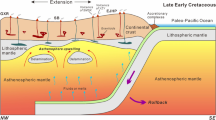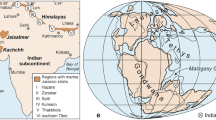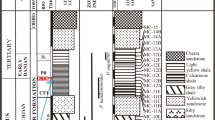Abstract
Ten meters of lacustrine deposits retrieved from Lake Pergusa (Sicily, southern Italy) were investigated through stable isotope composition (carbon and oxygen) of authigenic carbonate (calcareous muds) and freshwater shells. The core chronology was established through three AMS dates, and by correlation with a previously dated nearby core. Stable isotope data show that the lake water evolution was mainly dominated by evaporation. Between ca. 20 and 28 ka the recovered sediments have very high δ18O values, likely corresponding to very dry climatic conditions. The observed rapid oscillations in the δ18O of the recovered sediments during this period also suggest important climatic fluctuations. More humid conditions dominated during the Holocene period, with the wettest interval occurring between ca. 9000 and 3000 years BP. Late Holocene sediments represent a substantial return to drier conditions. The available pollen data from a nearby core substantially confirm this general climatic trend during the Holocene. The positive correlation between δ13C of the calcareous muds and carbonate content suggests that biological activity played a key role in the carbon isotope evolution of dissolved inorganic carbon. However, a clear climatic signal is not evident from the δ13C record.






Similar content being viewed by others
References
Anadón P, Moscariello A, Rodríguez-Lázaro J, Filippi ML (2006) Holocene environmental changes of Lake Geneva (Lac Léman) from stable isotopes (δ13C, δ18O) and trace element records of ostracod and gastropod carbonates. J Palolimnol 35:593–616
Bard E, Delaygue G, Rostek F, Antonioli F, Silenzi S, Schrag D (2002) Hydrological conditions in the western Mediterranean basin during the deposition of Sapropel 6 (ca. 175 kyr). Earth Planet Sci Lett 202:481–494
Bar-Matthews M, Ayalon A, Gimour M, Matthews A, Hawkwsworth C (2003) Sea–land oxygen isotopic relationships from planktonic foraminifera and speleothems in the Eastern Mediterranean region and their implications for paleorainfall during interglacial intervals. Geochim Cosmochim Acta 67:3181–3199
Bartov Y, Goldstein SL, Stein M, Enzel Y (2003). Catastrophic arid episodes in the Eastern Mediterranean linked with the North Atlantic Heinrich events. Geology 31:439–442
Baroni C, Bruschi G, Veronese L, Zanchetta G (2001) Younger Dryas to Early Holocene paleoenvironmental evolution of the Lake Terlano (Southern Alps). Geogr Fis Dinam Quat 24:13–24
Baroni C, Zanchetta G, Fallick AE, Longinelli A (2006) Mollusca stable isotope record of a core from Lake Frassino, northern Italy: hydrological and climatic changes during the last 14 ka. Holocene 16:827–837
Battaglia M, Cimino A, Gottini V, Dongarrà G, Hauser R, Ingrasciotta MV, Rizzo S, Sacco G (1991) Indagini geofisiche e geochimiche su un lago endoreico della Sicilia: Pergusa. Boll Soc Geol It 110:53–63
Bolle HJ (2003) Mediterranean vlimate. Variability and trends. Springer, Berlin
Bonadonna FP, Leone G (1995) Palaeoclimatological reconstruction using stable isotope data on continental molluscs from Valle di Castiglione, Rome, Italy. Holocene 5:461–469
Borghini A (2004) Nuovi dati su di una carota proveniente dal lago di Pergusa (Sicilia). Unpublished thesis, Facoltà di Scienze MFN, University of Pisa, Pisa
Bottger T, Hiller A, Junge FW, Litt T, Mania D, Scheele N (1998) Late Glacial stable isotope record, radiocarbon stratigraphy, pollen and mollusc analyses from the Geiseltal area, Central Germany. Boreas 27:88–100
Celle-Jeanton H, Gonfiantini R, Travi Y, Sol B (2004) Oxygen-18 variations of rainwater during precipitation: application of the Rayleigh model to selected rainfalls in Southern France. J Hydrol 289:165–177
Curry BB, Anderson TF, Lohmann KC (1997) Unusual carbon and oxygen isotopic ratios of ostracodal calcite from last interglacial (Sangamon episode) lacustrine sediment in Raymon Basin, Illinois, USA. J Paleolimnol 17:421–435
Dansgaard W, Johnsen SJ, Clausen HB, Dahl-Jensen D, Gundestrup NS, Hammer CU, Hvidberg CS, Steffensen JP, Sveinbjornsdottir AE, Jouzel J, Bond G (1993) Evidence for general instability of past climate from a 250-kyr ice-core record. Nature 364:218–220
Deines P (1980) The isotopic composition of reduced organic carbon. In: Fritz P, Fontes JCh (eds) Handbook of environmental isotope geochemistry I, The terrestrial environment. Elsevier, Amsterdam, 329–406
Drysdale RN, Zanchetta G, Hellstrom JC, Zhao J-x, Fallick AE, Isola I, Bruschi G (2004) Palaeoclimatic implications of the growth history and stable isotope (δ18O and δ13C) geochemistry of a Middle to Late Pleistocene stalagmite from central–western Italy. Earth Planet Sci Lett 227:215–229
Drysdale RN, Zanchetta G, Hellstrom J, Maas R, Fallick AE, Pickett M, Cartwright I, Piccini L, (2006) Late Holocene drought responsible for the collapse of Old World civilizations is recorded in an Italian cave flowstone. Geology 34:101–104
Eicher U, Siegenthaler U, (1976) Palynological and oxygen isotope investigations on Late-Glacial sediment cores from Swiss lakes. Boreas 5:109–117
Filippi ML, Moscariello A, Hunziker J (1997) Stable isotopes in Lake Geneva carbonate sediments and molluscs: review and new data. Eclogae Geol Helv 90:199–210
Follieri M, Magri D, Sadori L (1988) 250,000-year pollen record from Valle di Castiglione (Roma). Pollen et Spores 30:329–356
Follieri M, Magri D, Sadori L (1989) Pollen stratigraphical synthesis from Valle di Castiglione (Roma). Quat Int 3–4:81–84
Genty D, Blamart D, Ouahadi R, Gilmour M, Baker A, Jouzel J, Van-Exter S (2003) Precise dating of Dansgaard–Oescher climatic oscillations in western Europe from stalagmite data. Nature 421:833–837
Hammarlund D, Buchardt B (1996) Composite stable isotope records from a Late Weichselian lacustrine sequence at Graenge, Lolland, Denmark: evidence of Allerød and Younger Dryas environments. Boreas 25:8–22
Hammarlund D, Björck S, Buchardt B, Israelson C, Thomsen CT (2003) Rapid hydrological changes during the Holocene revealed by stable isotope records of lacustrine carbonates from Lake Igelsjön, southern Sweden. Quat Sci Rev 22:353–370
Holmes JA, Street-Perrott FA, Allen MJ, Fothergill PA, Harkness DD, Kroon D, Perrott RA (1997) Holocene palaeolimnology of Kajermarum Oasis, Northern Nigeria: an isotopic study of ostracods, bulk carbonate and organic carbon. J Geol Soc London 154:311–319
Huntley B, Watts WA, Allen JRM, Zolitschka B (1999) Paleoclimate, chronology and vegetation history of the Weichselian Lateglacial: comparative analysis of data from three cores at Lago Grande di Monticchio, southern Italy. Quat Sci Rev 18:945–960
Jalut G, Amat AE, Bonnet L, Gauquelin T, Fontugne M (2000) Holocene climatic changes in the Western Mediterranean from south-east France to south-east Spain. Palaeogeogr Palaeoclimatol Palaeoecol 160:255–290
Jeftic L, Milliman JD, Sestini G (1992) Climatic change and the Mediterranean. Edward Arnold, London
Jones MD, Leng MJ, Eastwood WJ, Keen DH, Turney CSM (2002) Interpreting stable-isotope records from freshwater snail-shell carbonate: a Holocene case study from Lake Gölhisar, Turkey. Holocene 12:629–634
Jones MD, Leng MJ, Roberts CN, Türkeş M, Moyeed R (2005) A coupled calibration and modelling approch to the understanding of dry-land lake oxygen isotope records. J Paleolimnol 34:391–411
Kallel N, Paterne M, Labeyrie L, Duplessy J-C, Arnold M (1997) Temperature and salinity records of the Tyrrhenian Sea during the last 18,000 years. Palaeogeogr Palaeoclimatol Palaeoecol 135:97–108
Kim ST, O’Neil JR (1997) Equilibrium and non-equilibrium oxygen isotope effects in synthetic carbonates. Geochim Cosmochim Acta 61:3461–3475
Kolodny Y, Stein M, Machlus M (2005) Sea–rain–lake relation in the Last Glacial East Mediterranean revealed by δ18O–δ13C Lake Lisan aragonites. Geochim Cosmochim Acta 69:4045–4060
Lemeille E, Letolle R, Meliere F, Olive P (1983) Isotopes and other physico-chemical parameters of paleolake carbonates. Tools for climatic reconstruction. In: Paleoclimate and Paleowaters. A collection of environmental isotope studies. IAEA, Vienna, pp 135–150
Leng M, Marshall JD (2004) Palaeoclimate interpretation of stable isotope data from lake sediment archives. Quat Sci Rev 23:811–831
Leng M, Roberts N, Reed JM, Sloane HJ (1999) Late Quaternary palaeohydrology of the Konya Basin, Turkey, based on isotope studies of modern hydrology and lacustrine carbonates. J Paleolimnol 22:187–204
Leone G, Leoni L, Sartori F (1988) Revisione di un metodo gasometrico per la determinazione di calcite e dolomite. Atti Soc Toscana Sc Nat Mem Serie A 95:7–20
Longinelli A, Piteo E, Selmo E, Iacumin P (2000) Isotope geochemistry of lacustrine and fluvio-lacustrine fossils from three cores from Rieti plain, Central Italy. Giorn Geol 63:173–188
Longinelli A, Selmo E (2003) Isotopic composition of precipitation in Italy: a first overall map. J Hydrol 270:75–88
Maheras P, Xoplaki E, Davies T, Martin-Vide J, Bariendos M, Alcoforado MJ (1999) Warm and cold monthly anomalies across the Mediterranean Basin and their relationship with circulation; 1860–1990. Int J Climatol 19:1697–1715
Martrat B, Grimald JO, Lopez-Martinez C, Cacho I, Sierro FJ, Flores JA, Zahn R, Canals M, Curtis JH, Hodell DA (2004) Abrupt temperature changes in the Western Mediterranean over the past 250,000 years. Science 306:1762–1765
McDermott F, Frisia S, Huang Y, Longinelli A, Spiro B, Heaton THE, Hawkesworth CJ, Borsato A, Keppens E, Fairchild IJ, Van Der Borg K, Verheyden S, Selmo E (1999) Holocene climate variability in Europe: evidence from δ18O, textural and extension-rate variations in three speleothems. Quat Sci Rev 18:1021–1038
Michel FA, Fritz P, Drimmie RJ (1989) Evidence of climatic change from oxygen and carbon isotope variations in sediments of a small arctic lake, Canada. J Quat Sc 4:201–209
Narcisi B (2002) Tephrostratigraphy of the late Quaternary lacustrine sediments of Lago di Pergusa (central Sicily). Boll Soc Geol It 121:211–219
Paul HA, Bernasconi SM, Schmid DW, McKenzie JA (2001) Oxygen isotopic composition of the Mediterranean Sea since the Last Glacial Maximum: constraints from pore water analyses. Earth Planet Sci Lett 192:1–14
Ramrath A, Sadori L, Negendank JFW (2000) Sediments from Lago di Mezzano, central Italy: a record of Lateglacial/Holocene climatic variations and anthropogenic impact. Holocene 10:87–95
Reimer PJ, Baillie MGL, Bard E, Bayliss A, Beck JW, Bertrand C, Blackwell PG, Buck CE, Burr G, Cutler KB, Damon PE, Edwards RL, Fairbanks RG, Friedrich M, Guilderson TP, Hughen KA, Kromer B, McCormac FG, Manning S, Bronk Ramsey C, Reimer RW, Remmele S, Southon JR, Stuiver M, Talamo S, Taylor FW, van der Plicht J,Weyhenmeyer CE (2004) InteCal04 Terrestrial Radiocarbon Age Calibration 0–26 Cal kyr BP. Radiocarbon 46:1029–1058
Roberts N, Reed JM, Leng MJ, Kuzucuoglu C, Fontugne M, Bertaux J, Woldring H, Bottema S, Black S, Hunt E, Karabiyikoglu M (2001) The tempo Holocene climatic change in the eastern Mediterranean region: new high-resolution crater-lake sediment data from central Turkey. Holocene 11:747–755
Rossignol-Strick M, Planchais N (1989) Climate patterns revealed by pollen and oxygen isotope records of a Tyrrhenian sea core. Nature 342:413–416
Sadori L, Narcisi B (2001) The Postglacial record of environmental history from Lago di Pergusa. Holocene 11:655–670
Schink JC, Stockwell JH, Ellis RA (1979) An improved device for gasometric determination of carbonate in sediment. J Sedim Petrol 49:651–653
Shanahan TM, Pigati JS, Dettman L, Quade L (2005) Isotopic variability in the aragonite shells of freshwater gastropods in springs with nearly constant temperature and isotopic composition. Geochim Cosmochim Acta 69:3949–3966
Siegenthaler U, Eicher U (1986) Stable oxygen and carbon isotope analyses. In: Berlglund BE (ed) Handbook of holocene palaeoecology and palaeohydrology. John Wiley & Sons Ltd, Chichester, pp 407–422
Stevens LR, Wright HE, Ito E (2001) Proposed changes in seasonality of climate during the Lateglacial and Holocene at Lake Zeribar, Iran. Holocene 11:747–755
Talbot MR (1990) A review of the paleohydrological interpretation of carbon and oxygen ratios in primary lacustrine carbonates. Chem Geol 80:261–279
von Grafenstein U, Erlenkeuse H, Kleinmann H, Muller J, Trimborn P (1994) High frequency climate oscillation during the last deglaciation as revealed in oxygen isotope records of benthic organisms (Ammersee, southern Germany). J Paleolimnol 11:349–357
von Grafenstein U, Erlenkeuse H, Trimborn P (1999) Oxygen and carbon isotopes in modern freshwater ostracod valves: assessment of vital offset and autoecological effects of interest for paleoclimate studies. Palaeogeogr Palaeoclimatol Palaeoecol 148:133–152
von Grafenstein U, Eicher U, Erlenkeuser H, Ruch P, Schwander J, Ammann B (2000) Isotope signature of the Younger Dryas and two minor oscillations at Gernensee (Switzerland): palaeoclimatic and palaeolimonologic interpretation based on bulk and biogenic carbonates. Palaeogeogr Palaeoclimatol Palaeoecol 159:215–229
White RMP, Dennis PF, Atkinson TC (1999) Experimental calibration and field investigation of the oxygen isotopic fractionation between biogenic aragonite and water. Rapid Commun Mass Spectrom 13:1242–1247
Wuster CM, Patterson WP (2001) Seasonal variation in stable oxygen and carbon isotope values recovered from modern lacustrine freshwater molluscs: paleoclimatological implications for sub-weekly temperature records. J Paleolimnol 26:205–218
Xoplaki E, Gonzàles-Rouco JF, Luterbacher J, Wanner H (2003) Mediterranean summer air temperature variability and its connection to the large-scale atmospheric circulation and SSTs. Clim Dynam 20:723–739
Zampino D, Duro A, Piccione V, Scalia C (1997) Fitoclima della Sicilia – Termodiagrammi secondo Walter e Lieth. Atti 5° Workshop. “Progetto Strategico Clima, Ambiente e Territorio nel Mezzogiorno” vol 2, pp 7–121
Zanchetta G, Bonadonna FP, Leone G (1999) A 37-meter record of paleoclimatological events from stable isotope data on continental molluscs in Valle di Castiglione, near Rome, Italy. Quat Res 52:293–299
Zanchetta G, Di Vito MA, Fallick AE, Sulpizio R (2000) Stable isotopes of pedogenic carbonates from the Somma-Vesuvius area, southern Italy, over the past 18 kyr: palaeoclimatic implications. J Quat Sc 15:813–824
Acknowledgements
We thank C. Brüchmann for her help in the core sampling and for supplying important information about the core; A. Tait, T. Donnelly, J. Dougans; M. Lazzerini are acknowledged for analytical support, and L. Sadori for the discussion about pollen data and stratigraphy. We also thank Valero-Garces for his constructive review, criticism and comments which improved the quality of the manuscript and R. N. Drysdale for the friendly revision of this manuscript. This work was partially founded by MURST (ex-60%, F.P. Bonadonna). SUERC is supported by a consortium of Scottish Universities and NERC.
Author information
Authors and Affiliations
Corresponding author
Rights and permissions
About this article
Cite this article
Zanchetta, G., Borghini, A., Fallick, A.E. et al. Late Quaternary palaeohydrology of Lake Pergusa (Sicily, southern Italy) as inferred by stable isotopes of lacustrine carbonates. J Paleolimnol 38, 227–239 (2007). https://doi.org/10.1007/s10933-006-9070-1
Received:
Accepted:
Published:
Issue Date:
DOI: https://doi.org/10.1007/s10933-006-9070-1




